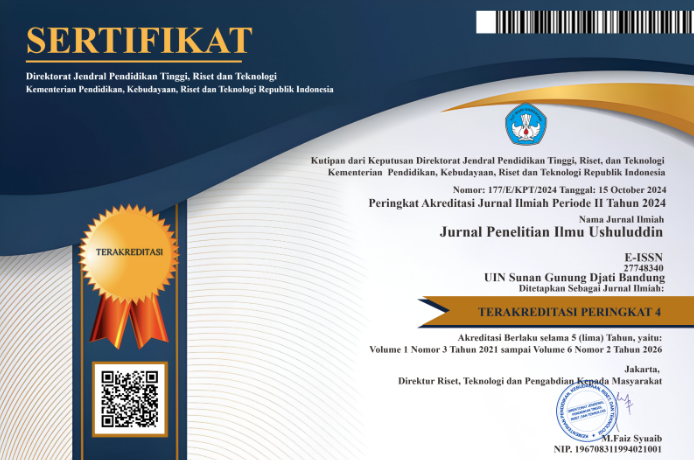Konsep Zinah dalam Al-Qur’an (Aplikasi Semiotika Roland Barthes terhadap QS. Al-Kahfi Ayat 7)
DOI:
https://doi.org/10.15575/jpiu.24757Keywords:
Roland Barthes, Semiotics, ZinahAbstract
The purpose of research is revealing concept of 'Zinah' from Al-Kahfi verse 7 and connecting with society now. The kinds of research are research of bibliography with a qualitative method and using semiotical analysis by Roland Barthes because it needs structural analysis in critical text. Properly, semiotical theory of Roland Barthes is two steps. First is Linguistic system or Denotation system. Second is Mythological system or Connotation system. From the connotation system will be found the mythical meaning. The result of research of linguistic system or denotation system is the word 'Zinah' translated jewelry or thing that makes the other thing becoming the beautiful. In the mythical system it is all of the things created by Allah in the earth earth including mountains, trees, seas, rivers, plants and animals that makes the earth look beautiful. Behind this beauty, Allah makes it challenging. So that from the mythical system, it can be taken the meaning of myth from the word 'Zinah', it is jewelry that properly, it is used by a girl community and have a highly precious value such as necklace, ring, armlet and others made by gold or silver. This research suggests further studying the meaning of 'Zinah' in the Al-Qur’an in QS. Al-Kahf verse 7 uses semiotic theories or other linguistic theories. Especially the theory of semiotics which can reveal a deeper meaning to the word meaning of 'Zinah'.References
‘Arabi, M. al-D. M. bin ‘Ali I. (2011). Tafsir Ibn ‘Arabi. Lebanon: Dar al-Kutub al-Ilmiyah.
Al-Baqi, M. F. A. (1996). al-Mu’jam al-Mufahris li Alfaz Al-Qur’an al-Karim. Kairo: Dar al-Kutub al-Misriyyah.
Al-Zamakhsyari. (2009). Tafsir Al-Kasyaf. Beirut: Dar Al-Marefah.
Ath-Thabari, A. J. M. bin J. (2007). Tafsir Ath-Thabari , Terj: Ahsan. Pustaka Azzam.
Az-Zuhaylī, W. (1991). Tafsir al-Munir Juz 8.
Az-Zuhaylī, W. (2013a). Tafsir Al-Munir Jilid 8. Jakarta: Gema Insani.
Az-Zuhaylī, W. (2013b). Tafsir al-Munir: Aqidah, Syariah, Manhaj Vol. 2 (terj. A. H). Jakarta: Gema Insani.
Barthes, R. (2006). Mitologi (terj. Nurh). Yogyakarta: Kreasi Wacana.
Barthes, R. (2007). Petualangan Semiologi (terj. Step). Yogyakarta: Pustaka Pelajar.
Barthes, R. (2017). Elemen-elemen Semiologi. Yogyakarta: Basabasi.
Berger, A. A. (2000). Tanda-tanda dalam Kebudayaan Kontemporer. (terj. M. D. Satrianto, Ed.).
Farhan, Sulistiani, R., & Fahruroji. (2021). Kajian Sistematis Al-Qur’an Surat al-Kahfi Ayat 1-10. Jurnal Pendidikan BASIS Bahasa Arab Dan Studi Islam, 5(2).
Hamka. (2003). Tafsir al-Azhar. Singapura: Pustaka Nasional PTE LTD.
Hariyani, R., Mahfuzh, T. W., & Apriansyah, A. (2022). Zinah dalam QS An-Nur (24): 3: Pendekatan Ma’na Cum Maghza. Syams: Jurnal Kajian Keislaman, 3(1), 35-48.
Hosein, I. N. (2006). Surah al-Kahf; Arabic Text, Translation, and Modern Commentary, terj. Kampungmuslim.org. Masjid Jami’ah.
Kamus Besar Bahasa Indonesia. (2005). Jakarta.
Katsir, I. (1998). Tafsir Al-Qur’an Al-’Azhim. Dar Al-Kotob Al-Ilmiyah.
Kumalasari, A. M. (2021). Makna Qiradah dalam Kisah Bani Israil. Al-Fanar: Jurnal Ilmu Al-Qur'an dan Tafsir, 4(2), 167-176.
Kurniawan. (2001). Semiologi Roland Barthes. Magelang: Indonesiatera.
Manzur, I. (2002). Lisan al-‘Arab. Kairo: Dar al-Ma’arif.
Maraghi, A. M. A. (2015). Tafsir Al-Maraghi Jilid 5. Beirut: Dar al-Kutub al-Ilmiyah.
Moleong, J. L. (2005). Metodologi Penelitian Kualitatif. Bandung: PT. Remaja Rosdakarya.
Mukhrim BM, B. (2016). Al-Zukhruf dalam al-Qur’an (Suatu Kajian Tafsir Maudu’i) (Doctoral dissertation, Universitas Islam Negeri Alauddin Makassar).
Munawwir, A. W. (1998). Kamus al-Munawwir Arab-Indonesia. Surabaya: Pustaka Progresif.
Munir, M. (2021). Mafhumu al-Zinah inda al-Maragi fi Tafsirihi. UIN Syarif Hidayatullah.
Ningsih. (2021). Korelasi Antara Surah Al-Kahfi 18:1-10 dengan Hadis-hadis Fadail Al-Suwar (Studi Analisis terhadap Tafsir Ruh al-Ma’ani Karya Imam al-Alusi). UIN Syarif Hidayatullah.
Rahman, F. (1996). Tema Pokok Al-Qur’an (terj. Anas). Bandung: Pustaka.
Shihab, M. Quraish. (2007). Secercah Cahaya Ilahi. Bandung: Mizan.
Shihab, Muhammad Quraish. (2002). Tafsir Al-Misbah: Pesan Kesan dan Keserasian Al-Qur’an Vol. 7 (1st ed.). Jakarta: Lentera Hati.
Shihab, Muhammad Quraish. (2010). Tafsir Al-Misbah Jilid 7. Ciputat: Lentera Hati.
Sunardi. (2004). Semiotika Negativa. Yogyakarta: Buku Baik.
Suryabrata, U. (1998). Metodologi Penelitian. Jakarta: PT. Raja Grafindo Persada.
Downloads
Published
Issue
Section
License
Authors who publish in Jurnal Penelitian Ilmu Ushuluddin agree to the following terms:
- Authors retain copyright and grant the journal right of first publication with the work simultaneously licensed under an Attribution-ShareAlike 4.0 International (CC BY-SA 4.0) License that allows others to share the work with an acknowledgment of the work's authorship and initial publication in this journal.
- Authors are able to enter into separate, additional contractual arrangements for the non-exclusive distribution of the journal's published version of the work (e.g., post it to an institutional repository or publish it in a book), with an acknowledgment of its initial publication in this journal.
- Authors are permitted and encouraged to post their work online (e.g., in institutional repositories or on their website) prior to and during the submission process, as it can lead to productive exchanges, as well as earlier and greater citation of published work (See The Effect of Open Access).












